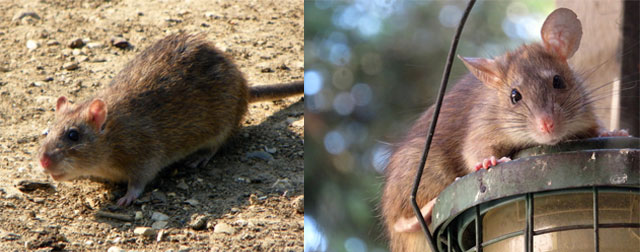We all know that rats are rodents that are often inside the house to disturb our life. But we don’t want to discuss how to expel these disturbing animals. Here we will explain the difference between Norway Rat Vs. Roof Rat.

Difference Between Norway Rat Vs Roof Rat
Roof Rat (Mus Musculus)
Roof rat is a member of Muridae. Roof mats are easily found in homes and are known as a harmful pest because of their destructive habits and nesting in the corners and roofs of houses.
This animal is thought to be the second largest mammal in the world, after humans. Roof rats are very easy to adjust to changes made by humans, even the numbers that live wild in the forest may be less than those who live in urban areas.
Roof rat has a length of 12-20 cm if measured from snout to tip of the tail with a weight of 12-30 grams. They are white, gray, light brown, dark brown, deep black, with a long mustache. Adult roof rat has a longer and thinner ear shape with a hairy tail. Mice can live up to 6 years in captivity even though they live less than 1 year naturally. They are responsible for spreading several diseases.
Norway Rat
In addition to white mice, many other types of mice raised are Norway rat or Rattus norvegicus. This mouse can be as big as a guinea pig. Generally, the Norwegian mice that are bred are white, so they look cleaner and not scary.
Norway rat has a larger size than the roof rat. Norway rat has a length of up to 40cm or more if measured from the muzzle to the tip of the tail. Some types of Norway rat are white, gray, light brown, dark brown, black, and white combinations. Norway rat has a more blunt muzzle than the roof rat.
Norway rat is a carrier of more than 45 types of diseases. Their natural habitat in culverts and waterways can cause water pollution. They are also sometimes found around residential areas so that it has the potential to pollute food and the environment. Mice can cause damage to agricultural areas.
Norwegian rats’ teeth grow faster than other types of mice so they must continue to cut so it is certain that their arrival will cause damage and loss. Their dirty habitats make them carriers of bacteria that can contaminate whatever they touch.
Both mice both have destructive behavior. Roof rat can damage various objects in the house and can make our home as their breeding habitat. Meanwhile, Norway rat, as a larger type, certainly can cause more damage.
Both are invasive animals that can live in one place for a very long time. Maintaining environmental cleanliness is one of the things that can prevent their breeding. Pest control must also be done immediately so as not to cause greater damage. Extermination must be done well to completely destroy all colonies in your home or environment. One thing you should know is that both Norway rat vs. roof rat are a pest.